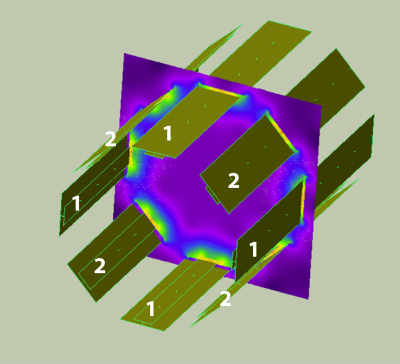4187
Reduced SAR excitation with linear phase coilsGlen Morrell1 and Rock Hadley1
1Radiology and Imaging Sciences, University of Utah, Salt Lake City, UT, United States
Synopsis
A novel method for SAR reduction for slice- or slab-selective excitation is proposed which uses an array of two linear phase RF coils and two channel transmission to reduce SAR with no change in pulse length, bandwidth, or slice profile compared to conventional excitation. FDTD simulation results show a reduction of SAR by a factor of two.
Purpose
To perform slice selective excitation with dramatically reduced SAR.Introduction
Patient heating due to SAR forces tradeoffs in MRI protocols such as reduced flip angles and increased imaging time. SAR constraints are severe at high field strengths, but are significant even at 1.5T field strength. We present a method combining custom transmit coil design and RF pulse software with two-channel parallel transmission that reduces SAR for axial slice selective excitation by a factor of 2 without affecting excitation slice profile or time. Our coil design is also suitable for conventional use as a single-channel volume excitation coil.Methods
Our method of reduced SAR slice selective excitation uses an array of two transmit coils, each of which has a transverse magnetic field profile with relatively uniform amplitude over the imaging volume but with opposite approximately linear phase along the longitudinal direction (1). These coils are coaxial around the same imaging volume. This configuration is illustrated in Figure 1, which shows two separately driven microstrip coils, each with four elements, which have the field profiles shown in Figure 2. Each of these coils is driven with a separate slice-selective RF waveform, such as a Hamming windowed sinc. The waveforms are scaled to half of the desired total flip and are offset relative to one another by a time increment Δt which, in combination with the slice selection gradient, corresponds to linear phase accrual equal to the intrinsic linear phase difference of the coils. The RF waveforms for the two coils are shown in Figure 3.Results
The B and E fields of the two-coil linear phase array were calculated by FDTD simulation (XFDT, Remcom) and used to perform RF simulation of slice selective excitation using each coil individually with conventional RF waveform design, and both coils simultaneously with the proposed method. Figure 2 shows the magnitude and angle of the transverse component of B determined by FDTD simulation at the center of each coil along its length. (For more details, see (1)). Figure 3 shows the RF excitations applied simultaneously to the two coils and the resulting slice profile of excitation along the center of the coils. Figure 4 shows the SAR corresponding to conventional slice selective excitation using just one of the coils, representing conventional excitation with a single volume coil, and with both coils simultaneously using the new method. SAR was calculated based on FDTD simulation of the electric field of both coils. SAR averaged over the imaging volume is decreased by a factor of 2.06 with the new method compared to single coil excitation.Discussion
Many methods have been employed to reduce SAR in slice selective excitation/refocusing including increased RF pulse length, variable rate selective excitation (VERSE) (2), and decreased flip angle for refocusing pulses in turbo-spin-echo imaging (3). These methods result in undesirable consequences including longer imaging time, decreased effective pulse bandwidth causing misregistration of fat and water excitation profiles, and contamination of T2 weighting caused by stimulated echoes from trains of refocusing pulses less than 180 degrees. Our proposed method has none of these drawbacks, achieving slice profile and RF pulse length identical to conventional RF excitation but with half the SAR. This effect arises from the combination of the two linear phase coil field profiles, which can combine constructively over parts of the imaging volume and destructively over other parts during the course of the RF excitation. Current results are based on FDTD simulation as we do not have access to a two-channel RF system. Future work will include hardware implementation and verification of the simulation results.Conclusion
A novel method of parallel transmission for axial slice selective excitation utilizing a set of two coils with linear phase variation along the through-slice direction (1) allows decrease in SAR by a factor of two for axial slice selective excitation with no increase in excitation time, no change in excitation bandwidth, and no change in slice profile compared to conventional slice selective excitation.Acknowledgements
No acknowledgement found.References
1. Hadley JR, Stack J, Roberts J, Merrill R, Parker DL, Morrell G. Linear phase non-resonant hybrid lumped element / twisted microstrip RF transmit coil. 20th Meeting ISMRM. Melbourne2012. p 2780.
2. Conolly S, Nishimura D, Macovski A, Glover G. Variable-rate selective excitation. J Magn Reson. 1988;78(3):440-458.
3. Hennig J, Scheffler K. Hyperechoes. Magn Reson Med. 2001;46(1):6-12.
Figures

Figure 1: Linear phase coil array. Four resistively
terminated microstrips form each of two linear phase coils (labeled “1” and “2”). The two coils are positioned as shown above,
one rotated by 45 degrees relative to the other. Each of the two coils is driven by a separate
RF amplifier with separate waveform (parallel transmission). A single axial plane B1 magnitude map from
FDTD simulation is superimposed on this figure showing relatively uniform B1
magnitude over a large volume inside the coil.

Figure 2: Field profile of linear phase coils. Magnitude and phase of transverse component of B field as a function of location along the center of the long axis of the two linear phase coils. Both coils achieve relatively uniform B1 magnitude with linearly varying phase. Results obtained from FDTD simulation of coils shown in Figure 1.

Figure 3: RF waveforms for each coil. Each waveform would result in the same slice selective excitation when used with its corresponding single coil. When combined simultaneously, the waveforms result in the same slice profile but markedly decreased total SAR. As shown in this figure, the waveforms are very slightly shifted in time relative to one another by an increment corresponding to the linear phase difference of the coils. Difference in RF amplitude is because of differing B field magnitude at the selected slice (see Fig. 2).

Figure 4: SAR for conventional slice selective excitation vs. new method. SAR along the coils’ long axis from slice selective excitation with single coil vs. combination of two coils simultaneously. SAR averaged over the coil length is reduced by a factor of 2.06, with no change in slice profile, flip angle, or excitation time. Results based on FDTD simulation of three-dimensional E field.